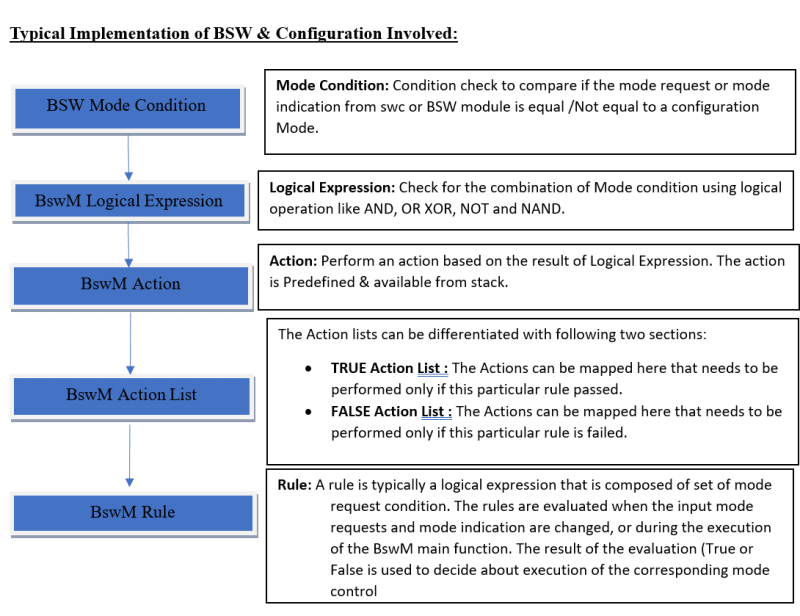Understanding Mode Management in Automotive Systems: A Comprehensive Overview

pooja1008-design
Posted on April 14, 2023

Hello All, I'm Pooja Shiraguppe employee of LUXOFT India. Here I would like to provide a brief knowledge about "Mode Management in Automotive Systems:A Comprehensive Overview".
As modern vehicles become more complex, the need for efficient and effective mode management becomes increasingly important. In automotive systems, mode management refers to the process of controlling and coordinating the state of electronic control units (ECUs) to optimize performance and power usage. This article provides a comprehensive overview of mode management in automotive systems, including its importance, key components, and typical implementation.
below fig. shows Mode Management in AUTOSAR.
Importance of Mode Management:-
- Mode management is crucial for optimizing the performance and power usage of modern vehicles. With multiple ECUs in operation.
- It is essential to manage them efficiently to avoid battery drain and ensure optimal system performance.
- Mode management allows for the coordination of ECUs based on conditions and requirements, ensuring that each ECU is only turned on when necessary, thus reducing overall power consumption and improving vehicle efficiency.
- ECUs control various vehicle systems, such as the engine, transmission, brakes, and steering.
- Depending on the driving conditions, different ECUs are activated to perform specific tasks. For example, during normal driving, the engine control unit (ECU) manages the engine performance. Still, during braking, the brake ECU takes over to ensure that the brakes operate correctly.
- If not managed correctly, ECUs can consume power even when not required, leading to battery drain and reduced vehicle efficiency. For example, an ECU that remains active even when the vehicle is parked can drain the battery, resulting in starting problems or even a dead battery. Therefore, efficient mode management is essential to ensure optimal power usage and prevent battery drain.
Components of Mode Management:-
Mode management in automotive systems is typically divided into two components: ECU state management (EcuM) and Basic Software mode manager (BswM).
EcuM:-
EcuM is responsible for managing the state of individual ECUs, including start-up and shut-down, run, and sleep state. EcuM provides a standard interface for managing the power state of an ECU, ensuring that ECUs only operate when necessary, reducing overall power consumption.
EcuM also ensures that ECUs start up and shut down in the correct sequence. For example, during vehicle start-up, EcuM ensures that the engine ECU is started before the transmission ECU, ensuring that the engine is running correctly before engaging the transmission.
BswM:-
- BswM is responsible for coordinating the behavior of multiple ECUs based on specific rules and conditions. BswM consists of two operational tasks: mode arbitration and mode control.
Mode arbitration: -
Mode arbitration initiates mode switches resulting from rule-based arbitration of mode requests and mode indications received from software components (SWCs) or other BSW modules.
Mode arbitration ensures that each ECU operates in the correct mode based on the current driving conditions and requirements.
Mode control:-
- Mode control, on the other hand, executes the resulting mode switches by activating or deactivating specific ECUs. Mode control ensures that the correct ECU is activated to perform the required task, reducing power consumption and optimizing vehicle performance.
Typical Implementation of BswM:-
The implementation of BswM involves the configuration of action lists, which are executed based on trigger or condition evaluation.
A trigger-based action list is executed only when the result of the rule evaluation changes from its previous state, while a condition-based action list is executed every time the rule is evaluated.
BswM also includes mode conditions, which evaluate to true or false based on specific conditions and events. For example, if an event request port is in a set state, the mode condition evaluates to true, and if it is in a clear state, the mode condition evaluates to false.
To ensure efficient and effective mode management, BswM must be configured correctly based on the specific requirements of the vehicle.
BswM implementation also involves mode request ports, which receive mode requests from other software components (SWCs) or BSW modules. These requests are then processed by the mode arbitration and mode control tasks to initiate mode switches.
Mode conditions can also be combined using AND, OR, and NOT logical operators to create complex mode conditions that consider multiple events and conditions.
For example, a mode condition can be defined as a combination of two events: engine speed exceeding a certain value AND transmission gear in a specific position.
Overall, BswM provides a flexible and customizable solution for mode management in automotive systems. The ability to define specific rules and conditions for mode switching allows for efficient and effective coordination of multiple ECUs, leading to improved vehicle efficiency and performance.
Conclusion:-
Mode management is a critical aspect of automotive systems, especially as vehicles become more complex and feature-rich. Effective mode management requires a comprehensive understanding of the key components and their typical implementation. In this article, we have discussed the importance of mode management in optimizing vehicle performance and power usage, as well as the key components of mode management: EcuM and BswM.
EcuM is responsible for managing the state of individual ECUs, while BswM coordinates the behavior of multiple ECUs based on specific rules and conditions. The implementation of BswM involves the configuration of action lists and mode conditions, which evaluate to true or false based on specific events and conditions.
By implementing effective mode management, automotive manufacturers can improve vehicle efficiency, reduce power consumption, and enhance overall performance. As automotive systems continue to evolve, mode management will remain a crucial aspect of ensuring optimal vehicle performance and reliability.

Posted on April 14, 2023
Join Our Newsletter. No Spam, Only the good stuff.
Sign up to receive the latest update from our blog.
Related

April 14, 2023

